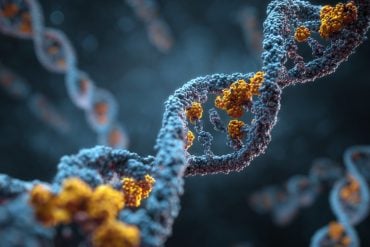Summary: A simple blood test may help to reveal a person’s risk of developing multiple sclerosis, According to a new study, low levels of vitamin D in the blood is linked to a higher risk of developing MS, especially in young and middle aged women.
Source: AAN.
Examining vitamin D levels in the blood may help predict whether a person is at risk of developing multiple sclerosis (MS), according to a large new study published in the September 13, 2017, online issue of Neurology.
“There have only been a few small studies suggesting that levels of vitamin D in the blood can predict risk,” said study author Kassandra Munger, ScD, of the Harvard T.H. Chan School of Public Health in Boston. “Our study, involving a large number of women, suggests that correcting vitamin D deficiency in young and middle-age women may reduce their future risk of MS.”
For the study, researchers used a repository of blood samples from more than 800,000 women in Finland, taken as part of prenatal testing. Then the researchers identified 1,092 women who were diagnosed with MS an average of nine years after giving the blood samples. They were compared to 2,123 women who did not develop the disease.

Deficient levels of vitamin D were defined as fewer than 30 nanomoles per liter (nmol/L). Insufficient levels were 30 to 49 nmol/L and adequate levels were 50 nmol/L or higher.
Of the women who developed MS, 58 percent had deficient levels of vitamin D, compared to 52 percent of the women who did not develop the disease.
Researchers found that with each 50 nmol/L increase in vitamin D levels in the blood, the risk of developing MS later in life decreased by 39 percent. In addition, women who had deficient levels of vitamin D had a 43 percent higher risk of developing MS than women who had adequate levels as well as a 27 percent higher risk than women with insufficient levels.
“More research is needed on the optimal dose of vitamin D for reducing risk of MS,” said Munger. “But striving to achieve vitamin D sufficiency over the course of a person’s life will likely have multiple health benefits.”
Limitations of the study include that participants were primarily white women and therefore the findings may not be the same for other racial groups or men. Also, while the blood samples were taken an average of nine years before MS diagnosis, it is possible some women may have already had MS when blood was drawn and were not yet showing symptoms of the disease.
Funding: The study was supported by the National Institute of Neurological Disorders and Stroke.
Source: Renee Tessman – AAN
Image Source: NeuroscienceNews.com image is in the public domain.
Original Research: Abstract for “25-Hydroxyvitamin D deficiency and risk of MS among women in the Finnish Maternity Cohort” by Kassandra L. Munger, Kira Hongell, Julia Åivo, Merja Soilu-Hänninen, Heljä-Marja Surcel, and Alberto Ascherio in Neurology. Published online September 13 2017 doi:10.1212/WNL.0000000000004489
[cbtabs][cbtab title=”MLA”]AAN “Vitamin D Levels in Blood May Predict Multiple Sclerosis Risk.” NeuroscienceNews. NeuroscienceNews, 16 September 2017.
<https://neurosciencenews.com/multiple-sclerosis-vitamin-d-7499/>.[/cbtab][cbtab title=”APA”]AAN (2017, September 16). Vitamin D Levels in Blood May Predict Multiple Sclerosis Risk. NeuroscienceNew. Retrieved September 16, 2017 from https://neurosciencenews.com/multiple-sclerosis-vitamin-d-7499/[/cbtab][cbtab title=”Chicago”]AAN “Vitamin D Levels in Blood May Predict Multiple Sclerosis Risk.” https://neurosciencenews.com/multiple-sclerosis-vitamin-d-7499/ (accessed September 16, 2017).[/cbtab][/cbtabs]
Abstract
25-Hydroxyvitamin D deficiency and risk of MS among women in the Finnish Maternity Cohort
Methods: We conducted a prospective nested case-control study among women in the Finnish Maternity Cohort (FMC). The FMC had 1.8 million stored serum samples taken during the pregnancies of over 800,000 women at the time of this study. Through linkages with hospital and prescription registries, we identified 1,092 women with MS diagnosed between 1983 and 2009 with at least 1 serum sample collected prior to date of MS diagnosis; ≥2 serum samples were available for 511 cases. Cases were matched to up to 3 controls (n = 2,123) on date of birth (±2 years) and area of residence. 25-Hydroxyvitamin D (25[OH]D) levels were measured using a chemiluminescence assay. We used conditional logistic regression adjusted for year of sample collection, gravidity, and parity to estimate relative risks (RRs) and 95% confidence intervals (CIs).
Results: A 50 nmol/L increase in 25(OH)D was associated with a 39% reduced risk of MS (RR 0.61, 95% CI 0.44–0.85), p = 0.003. Women with 25(OH)D levels <30 nmol/L had a 43% higher MS risk (RR 1.43, 95% CI 1.02–1.99, p = 0.04) as compared to women with levels ≥50 nmol/L. In women with ≥2 samples, MS risk was 2-fold higher in women with 25(OH)D <30 nmol/L as compared to women with 25(OH)D ≥50 nmol/L (RR 2.02, 95% CI 1.18–3.45, p = 0.01).
Conclusions: These results directly support vitamin D deficiency as a risk factor for MS and strengthen the rationale for broad public health interventions to improve vitamin D levels.
“25-Hydroxyvitamin D deficiency and risk of MS among women in the Finnish Maternity Cohort” by Kassandra L. Munger, Kira Hongell, Julia Åivo, Merja Soilu-Hänninen, Heljä-Marja Surcel, and Alberto Ascherio in Neurology. Published online September 13 2017 doi:10.1212/WNL.0000000000004489







